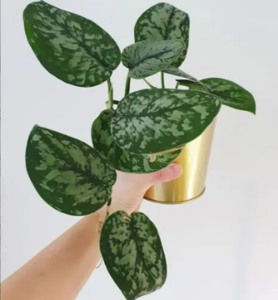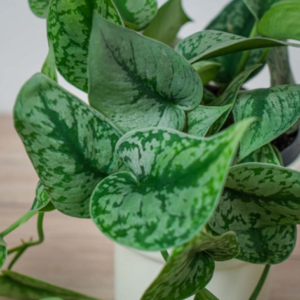The Scindapsus genus of climbing vines has 35 varieties and the most commonly cultivated of these is Scindapsus pictus. The Latin pictus just means painted, referring to the variegation on the leaves. The Scindapsus is closely related to the Epipremnum and the main difference is seen in the number of seeds produced. Neither Scindapsus nor Epipremnum produce flowers easily under houseplant cultivation. These tropical plants are grown for their foliage and their capacity to tolerate less than ideal growing conditions.
Scindapsus goes by many common names, mostly you will see it sold as satin pothos or silver vine. It originates in the tropical rainforests of Southeast Asia, and its adaptability makes it an excellent choice for both beginners and experienced indoor gardeners.
One of the reasons for its ease of care is its capacity to tolerate a wide range of light conditions. While it thrives in bright light, it can tolerate lower light levels, making it versatile for various indoor spaces. It just won’t grow as fast. It’s an ideal option for homes or offices with limited natural light. But it won’t do well in the dark. It won’t grow at all.
Knowing when to water Scindapsus pictus is straightforward – if the leaves start to sag a little, give it a thorough soaking and allow to drain. Better still, use a bamboo chopstick to test if the potting mix is dry: push the chopstick all the way to the bottom of the mix against the edge of the pot. If it comes out dry, give the plant a good watering. It will tolerate drying out between waterings and will cope better with underwatering than overwatering. Like any plant, it is susceptible to root rot if kept consistently soggy. Always use an appropriate, airy, well-draining potting mix to prevent excess moisture retention.
Another aspect contributing to its easy care is its resilience against common pests and diseases. While it’s not completely immune, Scindapsus pictus is generally resistant to many issues that plague other indoor plants. This hardy and attractive houseplant has certainly earned its reputation as an easy and low-maintenance addition to any home or office.
With Scindapsus pictus you have a lot of choices:
- Scindapsus pictus ‘Argyraeus’: This cultivar has silver-gray foliage with dark green spots and streaks. (Image – Jungle Collective)
- Scindapsus pictus ‘Exotica’: Also known as Scindapsus pictus ‘Silvery Ann,’ this variety features striking silver patches on its leaves. (Image – Jungle Collective)
- Scindapsus pictus ‘Silver Lady’: ‘Silver Lady’ has smaller leaves than the standard Scindapsus pictus and showcases a beautiful silver pattern. (Image – Jungle Collective)
- Scindapsus pictus ‘Silver Satin’: This cultivar has a rich silver sheen on its leaves and is highly sought after by plant enthusiasts. (Image – Houseplant Jungle)
- Scindapsus pictus ‘Silver Splash’: As the name suggests, this variety has splashes of silver on its leaves, creating an eye-catching effect. (Image – Brittany Goldwyn)
- Scindapsus pictus ‘Trebie’: ‘Trebie’ is recognized for its elongated, silver-streaked leaves. (Image – Malasz Klarnia)
- Scindapsus pictus ‘Exotica Trebie’: This is a combination of the ‘Exotica’ and ‘Trebie’ varieties, with both silver patches and streaks on its leaves. (Image – Feels Like Home)

Image: Houseplant Jungle 2023






They all look great and will all grow in a similar fashion. I generally can’t tell the difference between them as juvenile plants and my suspicious nature makes me inclined to disbelieve the plant tags in most cases. They are commonly available, so don’t go paying a high price for one. It’s best to buy one of these lovely plants from a reputable grower so you can be sure you are getting what you want, and what you pay for.
As with the Epipremnums, the Scindapsus will not have a cataphyll covering new leaves and it will have just one short, nubby root per node – remember that Philodendrons have cataphylls and at least two thin roots per node.

